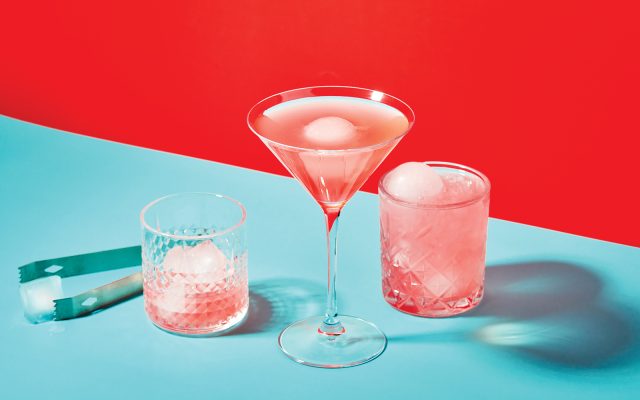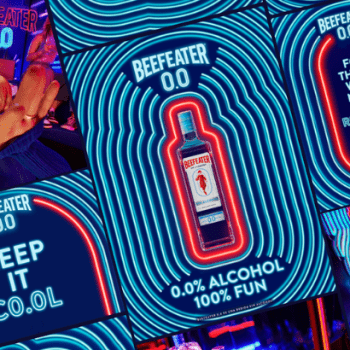The battle between low and no
Despite being a young category, the low-and-no space is developing at pace, with alcohol-free brands leading the charge.

*This feature was originally published in the February 2024 issue of The Spirits Business magazine.
“Explosive, nascent, saturated,” – these are the three words used to describe the low-and-no category by Ben Branson, founder of sector pioneer Seedlip. He believes that more than 1,000 new low-and-no brands have launched globally since 2020, with growth led by no-alcohol products, a comment backed by data from IWSR Drinks Market Analysis.
From Diageo’s alcohol-free Gordon’s and Tanqueray gins to Branson’s new non-alcoholic cocktail bitters line Seasn, there’s no shortage of alcohol alternatives on the market. There are also plenty of lower-ABV options too, including the 20% ABV Beefeater Light and Quarter, the ‘world’s first light Tequila’, at 12% ABV.
IWSR’s recent no/low report revealed that the sector is expected to rise by a compound annual growth rate (CAGR) of 6% from 2023 to 2027 in 10 key markets. The category’s growth will be driven by no-alcohol, rather than low-alcohol (defined as 30% ABV and under), IWSR estimates. No-alcohol is predicted to increase by 7%, with low-alcohol up by 3% over the same period.
Susie Goldspink, head of no- and low-alcohol at IWSR, said the low-and-no category reached its peak in 2021. Speaking specifically about the low/no ‘spirits’ segment, Goldspink said the sector’s growth has plateaued to an approximate 4% mark after growing by double digits in 2021.
Sector under threat
Goldspink said the sector has seen lots of innovation and vast improvements in production but is now threatened by the rise of categories such as functional drinks in the US. She also cites the challenges of regulating products. In comparison, IWSR expects huge growth for beer, which is more established when it comes to low-and-no options, with a growth rate of 7%. Goldspink says the no-alcohol category caters to those who are seeking moderation, rather than abstainers.
No-alcohol also offers a “more simplified proposition” as consumers can get confused about the alcohol content of a long drink that is mixed with a lower-ABV product. Another factor holding back low-and-no ‘spirits’ is the price of a bottle, compared with, say, beer.
Despite slower growth for low-and-no ‘spirits’, established markets such as the UK and the US are major hubs. “The UK is a big market in terms of no-and-low ‘spirits’. Relative to its size, it’s the home of a new generation of non-alcoholic innovation,” says Goldspink. “We’re expecting double-digit growth in the past year in the UK [13%] but going down to single digits – approximately 4% over the next five years [2023-2027].”
Goldspink says the US tends to be a bigger market for low-alcohol ‘spirits’, but it is expected to decline by 9% CAGR between 2023 and 2027. In the US, IWSR predicts CAGR volume growth of 14% for non-alcoholic ‘spirits’ over the next five years. “Most of the key markets do tend to have that kind of discrepancy,” she explains. She also singled out France as a growth market for the category, led by younger drinkers. “We’re seeing a bit of a shift in France in terms of younger consumers and new types of products.” France is expected to report a CAGR increase of approximately 11% for low-alcohol spirits over the next five years, while no-alcohol is due to drop by 1%.
 In 2022 French company Pernod Ricard established a division dedicated to the no-and-low category, recently launching Beefeater 0.0% in Spain as the first line extension from its portfolio of strategic international brands. Pernod Ricard has also created a research-and-development hub for the sector in the South of France, with a production line for non-alcoholic ‘spirits’.
In 2022 French company Pernod Ricard established a division dedicated to the no-and-low category, recently launching Beefeater 0.0% in Spain as the first line extension from its portfolio of strategic international brands. Pernod Ricard has also created a research-and-development hub for the sector in the South of France, with a production line for non-alcoholic ‘spirits’.
Solène Marchand, head of marketing for non-alcoholic at Pernod Ricard, believes the “strongest traction” is coming from the alcohol-free ‘spirits’ category. It will be a big focus for the group in the future, Marchand confirms, “based on our insights and tests”. She hasn’t ruled out future alcohol-free line extensions for other major brands in the portfolio, with a “strong innovation pipeline” planned. “We’ll definitely have this large multi-category portfolio that will be part-brand extension and part new-to-world brands,” she adds.
Australian alcohol-free brand Lyre’s, which has a portfolio of 18 non-alcoholic ‘spirits’, has little intention of entering the low-ABV space. The company’s recently appointed CEO, Paul Gloster, says: “The thing about Lyre’s is that it actually plays in both [segments]. What we’re seeing organically is that people are using Lyre’s to make drinks. It’s got the same taste as the traditional alcoholic spirits so you’ve got this almost seamless switch. So you can go from no to low to full strength and still have the same style of drink. So it probably makes sense for us as a brand to stay in the no-[alcohol] space.” He also notes that no-alcohol benefits from providing certainty to the consumer that the drink contains no alcohol. “There’s no potential for confusion,” he adds.
Lower ABVs

Like Lyre’s, UK alcohol-free brand Crossip is hoping to “replace alcoholic drinks” by “creating existing drinks” with a lower ABV, such as a Negroni, according to John Logue, the brand’s head of marketing. The company, which will expand into the US this year, is also looking to Asian markets and countries such as Saudi Arabia and Abu Dhabi. A big focus for this year will be its expansion into the on-trade, starting with trying to secure listings in the World’s 50 Best Bars, then hotel chains and cocktail bar groups, says Logue.
In 10 key markets analysed by IWSR, the no-alcohol category has a split of 15% on-trade, 70% off-trade, and 15% e-commerce. This signals huge potential for growth in bars and restaurants, a channel where a full-strength spirit brand is usually established before heading for retail.
Goldspink highlights that one barrier to growth for non-alcoholic ‘spirits’ is their price, with smaller bottle formats providing sampling opportunities. “We’ve seen brands go down from 70cl to a 50cl, and reducing price points,” she explains. It’s also particularly challenging in the current economic climate as consumers deal with the cost-of-living crisis, and when faced with a full-strength spirit versus an alcohol-free alternative, the former is likely to trump it.

Laura Willoughby, founder of London-based alcohol-free retailer Club Soda, makes a similar point, saying people are opting for wine over spirits. “Cost of living hits spirits more,” she notes, while the limited shelf life can also have an impact. “Once it’s open, it’s a challenge. We educate the consumer to put it in the fridge and consume it within three months.” The typical shelf life of an alcohol-free ‘spirit’ is two years before opening. Due to the category being new, she says more testing is needed before bottles can last longer. “As the years go by, there will be more data so shelf life can be extended.”
In terms of emerging markets for the sector, IWSR expects good growth in Australia (up by 12% CAGR 2023-2027], as well as South Africa, which is predicted to rise by 8% over the same period. Goldspink says the low-and-no sector is “relatively underserviced at the moment; the movement is still very nascent. It’s very concentrated in high-wealth areas, and there’s still so much potential for growth across the categories”.
Other strong markets for non-alcoholic ‘spirits’ over the next five years include Germany (up by 11%), Spain (up by 6%), and Japan (up by 6%). Meanwhile, Brazil (up 13%), France (up 11%) and the UK (up 7%) are expected to post growth for low-alcohol ‘spirits’ over the same period.
Western Europe, Australia and the Middle East are the core markets for Lyre’s, which “pulled back” from certain countries after going “a little bit too far too early”. Gloster said the company has shifted its focus from areas such as China and South Africa, as it is “not big enough to service them yet”.
There has also been an increasing number of agave spirit alternatives joining the category, including the likes of Almave (created by F1 racing driver Lewis Hamilton and Casa Lumbre) and Seedlip’s latest line extension in the US, Notas de Agave. In the UK, the volume of alcohol-free agave ‘spirits’ more than doubled in 2022, and in the US, the segment is set for further growth.
RTDs are also helping to drive sampling opportunities for alcohol-free ‘spirits’ thanks to their smaller format. Club Soda’s Willoughby has seen a boom in RTDs. “Our shop is close to theatres so people take them there. People are keen to try it as it’s cheaper; it drives discovery.”
For the category to grow, Goldspink says that retailers could “bring down prices somewhat so that they are lower than alcohol products” and create dedicated areas for low-and-no products to help “educate consumers”.
Willoughby is also hoping to “solve the retail gap” and get low-and-no products into smaller retail spaces, beyond supermarkets.
She adds: “I’d also like to see more adoption in the on-trade outside of London, and more curation of alcohol-free sections in independent and medium-sized retailers.”
How important is the on-trade for growing sales, and what do you have planned for the channel?
Eugenio Muraro – founder and CEO, MeMento
“The on-trade channel is crucial for the development of the no-and-low category. The products start to be known by those in the industry, but for the majority they are very innovative, bringing a cultural revolution in the way of drinking. This is why they must be introduced in the right way by the professionals in order to become part of common consumption. Bartenders must become the first evangelists of no-and-low, and we have invested with MeMento for several years in the training, starting from hotel schools with the young people who will lead the bar industry in the future.”
Giuseppe Gallo – founder, Italicus and Savoia
“The on-trade is a high focus for our innovative brands, especially in the growing no-and-low spirits trends. At the start of the year we launched the new edition of our bartender’s programme and competition, the Art of Italicus Aperitivo Challenge, with the aim of encouraging bartenders to be creative, learn more about the brand and experience our international bartending community, having the chance to win a trip to the global finals in Rome and a mentorship programme for the global winner at Cafe La Trova in Miami. At the same time, the Savoia brand has been supporting special menu activations across London, Milan, Florence, Miami, and New York for the low-ABV month, and to drive education for vegan/plant-based ingredients with the Vegan Road project.”
Fergus Fitzgerald – production director, Adnams
“All drinks brands rely on customers forming a connection to that brand, on it being part of memorable experiences, and the pub is the epicentre of that. We’ve seen first-hand with beer and Ghost Ship 0.5% that the delivery in pubs and being treated like any other beer elevates it from a reluctant choice born out of necessity into one that customers actively choose based on flavour and enjoyment. For our low/no gin, Smidgin, the on-trade is equally as important. We want pubs to be able to offer a low-alcohol G&T that doesn’t feel like a compromise to customers, and doesn’t result in excess wastage for pubs from a short shelf life. So Smidgin delivers for both. We need to make low/no options as easily visible as all other drinks categories. If customers have to ask what the low/no options are then it’s likely we’ve already lost potential sales.”
Related news
Spirits in limbo as RNDC exit disrupts California
